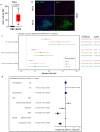This is a preprint.
Respiratory viral infection promotes the awakening and outgrowth of dormant metastatic breast cancer cells in lungs
- PMID: 38645169
- PMCID: PMC11030513
- DOI: 10.21203/rs.3.rs-4210090/v1
Respiratory viral infection promotes the awakening and outgrowth of dormant metastatic breast cancer cells in lungs
Update in
-
Respiratory viral infections awaken metastatic breast cancer cells in lungs.Nature. 2025 Sep;645(8080):496-506. doi: 10.1038/s41586-025-09332-0. Epub 2025 Jul 30. Nature. 2025. PMID: 40739350 Free PMC article.
Abstract
Breast cancer is the second most common cancer globally. Most deaths from breast cancer are due to metastatic disease which often follows long periods of clinical dormancy1. Understanding the mechanisms that disrupt the quiescence of dormant disseminated cancer cells (DCC) is crucial for addressing metastatic progression. Infection with respiratory viruses (e.g. influenza or SARS-CoV-2) is common and triggers an inflammatory response locally and systemically2,3. Here we show that influenza virus infection leads to loss of the pro-dormancy mesenchymal phenotype in breast DCC in the lung, causing DCC proliferation within days of infection, and a greater than 100-fold expansion of carcinoma cells into metastatic lesions within two weeks. Such DCC phenotypic change and expansion is interleukin-6 (IL-6)-dependent. We further show that CD4 T cells are required for the maintenance of pulmonary metastatic burden post-influenza virus infection, in part through attenuation of CD8 cell responses in the lungs. Single-cell RNA-seq analyses reveal DCC-dependent impairment of T-cell activation in the lungs of infected mice. SARS-CoV-2 infected mice also showed increased breast DCC expansion in lungs post-infection. Expanding our findings to human observational data, we observed that cancer survivors contracting a SARS-CoV-2 infection have substantially increased risks of lung metastatic progression and cancer-related death compared to cancer survivors who did not. These discoveries underscore the significant impact of respiratory viral infections on the resurgence of metastatic cancer, offering novel insights into the interconnection between infectious diseases and cancer metastasis.
Conflict of interest statement
Additional Declarations: Yes there is potential Competing Interest. HM has consulted Astra Zeneca relating to the use of monoclonal antibodies in the prevention and treatment of SARS-CoV-2 infection. J.A.A-G is a scientific co-founder, scientific advisory board member and equity owner in HiberCell and receives financial compensation as a consultant for HiberCell, a Mount Sinai spin-off company focused on the research and development of therapeutics that prevent or delay the recurrence of cancer. J.A.A-G is also a consultant for Astrin Biosciences, Inc and chief mission officer of Samuel Waxman Cancer Research Foundation.
Figures





References
Publication types
Grants and funding
LinkOut - more resources
Full Text Sources
Research Materials
Miscellaneous

